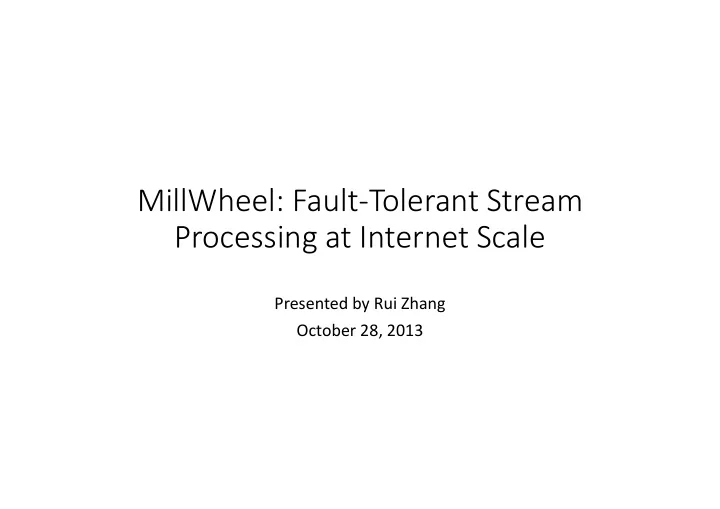

MillWheel: Fault ‐ Tolerant Stream Processing at Internet Scale Presented by Rui Zhang October 28, 2013
What is MillWheel? • Stream processing framework • Simple programming models • User ‐ specified directed computation graph • Fault ‐ tolerance guarantees • Scalability
Requirements by example • Persistent Storage • Short ‐ term and long ‐ term • Low Watermarks • Distinguish late records • Duplicate Prevention
Overview • Input and output triple • (key, value, timestamp)
Overview Key A Key A Key A • Computation Key B Key B Key B • Triggered upon receipt of record • Dynamically topology Wall time • Run in the context of a single key • Parallel per ‐ key processing Window Model Spike/Dip Anomaly Counter Calculator Detector Notifications
Overview • Keys • Abstraction for record aggregation and comparison • Computation can only access state for the specific key • Key extraction function • Specified by each consumer on per ‐ stream basis Window Model Spike/Dip Anomaly Counter Calculator Detector Notifications Key Extractor Stream:Q ueries
Overview • Streams • Delivery mechanism between computations • Computation can get input from multiple streams and also produce records to multiple streams Window Model Spike/Dip Anomaly Counter Calculator Detector Notification
Overview • Persistent State • Managed on per ‐ key basis • Stored in Bigtable or Spanner • Common use • Aggregation, buffered data for joins Window Model Computation Computation Counter Calculator A C
API • Computation API • ProcessRecord • Triggered when receiving a record • ProcessTimer • Triggered at a specific value or low watermark value • Timers are stored in persistent state • Not necessary
Fetch and manipulate state API Set Timer Produce Record
API • Low Watermark • At the system layer • Compute the low watermark value for all the pending work • Computation code rarely communicate with low watermarks
API • Injectors • Bring external data into MillWheel • Publish the injector low watermark • Distributed across many processes • Injector low watermark is determined among those processes
Key Features • Low Watermark Comput Comput • Min(oldest work of A, low watermark of C) ation C ation A • Late records • Records behind the low watermark • Process them according to application (discard or correct the result) • Monotonic in the face of late data
Key Features • Low Watermark
Sender Key Features Having received Ack receive no Ack Send Stop request sending • Delivery Guarantees • Exactly ‐ Once Delivery • Unique ID for every record Duplicate Record? • Bloom filter to provide fast path Y n • Garbage collection for record IDs E o S • Delay for those frequently delivering late data Process • Duplicate checking can be disabled Discard Record Send Acks Commit pending changes Send productio ns
Key Features • Delivery Guarantees • Strong Productions • Checkpoint before delivering productions • Checkpoint data will be deleted once productions succeed
Key Features • Delivery Guarantees • Weak Productions • For computations inherently idempotent • Broadcast downstream without checkpointing • End ‐ to ‐ end latency • Partial checkpointing
Key Features • Delivery Guarantees • Weak Productions
Key Features • State Manipulation • Wrap all per ‐ key updates into an atomic operation in case of crash • Per ‐ key consistency • timer, user state, production checkpoints • Single ‐ writer guarantee • Avoid zombie writers and network remnants issuing stale writes • Sequencer token • Check the validity before committing writes • Critical for both hard state and soft state
Key Features • State Manipulation
Implementation • Architecture • Each computation runs on one or more machines • Streams are delivered through RPC • On each machine: • Marshals incoming work • Manages process ‐ level metadata • Delegates to corresponding computation
Implementation • Architecture • Load distribution and balancing • Handled by replicated master • Key intervals • Keep changing according to CPU load and memory pressure Sequencer Sequencer Sequencer 1 Sequencer 2 Sequencer 3 Sequencer n n ‐ 2 n ‐ 1 Interval Interval …… Interval 1 Interval 2 Interval 3 Interval n n ‐ 2 n ‐ 1 Machin Machin Machin Machin Machin Machin es es es es es es
Implementation • Architecture • Persistent state • Bigtable or Spanner • Data for a particular key are stored in the same row • Timers, pending productions, persistent state • Recover from failure efficiently by scanning metadata • Consistency is important
Implementation • Low Watermark • Central authority • Track all low watermark values across the system • Store them in persistent state in case of failure • Each process aggregates their own timestamp information and send to central authority • Bucketed into key intervals Interval 1:k Interval 2:m Interval 3:n Interval 4:j missing machines machines machines machines
Implementation • Low Watermark • Central authority • Minima are computed by workers • Sequencer for low watermark updates • Scalability • Sharded across multiple machines
Evaluation • Output latency • Idempotent guarantee can increase latency a lot • Watermark lag • Proportional to the pipeline distance from the injector • Framework ‐ level caching • Increasing available cache improves the CPU usage linearly
Comparison • Punctuation ‐ based system • Use special annotations embedded in data streams to specify the end of a subset of data • Indicate no more records will come which match the punctuation • Gigascope • Heartbeat based system • Heartbeats carry temporal update tuples • Heartbeats monitor the system performance and check the node failure • Drawbacks of these systems • Need to generate artificial messages even though there are no new records • Utilize a more aggressive checkpointing protocol where they track every record processed
Recommend
More recommend